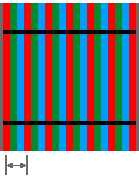
In the 1960s, Sony developed an alternative tube technology known as Trinitron. It combined the three separate electron guns into one device: Sony refers to this as a Pan Focus gun. Most interesting of all, Trinitron tubes were made from sections of a cylinder, vertically flat and horizontally curved, as opposed to conventional tubes using sections of a sphere which are curved in both axes. Rather than grouping dots of red, green and blue phosphor in triads, Trinitron tubes lay their coloured phosphors down in uninterrupted vertical stripes.
Consequently, rather than use a solid perforated sheet, Trinitron tubes use masks which separate the entire stripes instead of each dot – and Sony calls this the aperture grill. This replaces the shadow mask with a series of narrow alloy strips that run vertically across the inside of the tube. Their equivalent measure to a shadow mask’s dot pitch is known as stripe pitch. Rather than using conventional phosphor dot triplets, aperture grill-based tubes have phosphor lines with no horizontal breaks, and so rely on the accuracy of the electron beam to define the top and bottom edges of a pixel. Since less of the screen area is occupied by the mask and the phosphor is uninterrupted vertically, more of it can glow, resulting in a brighter, more vibrant display.
Aperture grill monitors also confer advantages with respect to the sharpness of an image’s focus. Since more light can pass through an aperture grill than a shadow mask, it means that bright images can be displayed with less current. The more current needed to write an image to the screen, the thicker the electron beam becomes. The consequence of this is that the electron beam illuminates areas around the spot for which it is intended, causing the edges of the intended image to blur.
Because aperture grill strips are very narrow, there’s a possibility that they might move, due to expansion or vibration. In an attempt to eliminate this, horizontal damper wires are fitted to increase stability. This reduces the chances of aperture grill misalignment, which can cause vertical streaking and blurring. The down side is that because the damper wires obstruct the flow of electrons to the phosphors, they are just visible upon close inspection. Trinitron tubes below 17in or so get away with one wire, while the larger model require two. A further down side is mechanical instability. A tap on the side of a Trinitron monitor can cause the image wobble noticeably for a moment. This is understandable given that the aperture grill’s fine vertical wires are held steady in only one or two places, horizontally.
Mitsubishi followed Sony’s lead with the design of its similar Diamondtron tube.
- The Anatomy of a CRT Monitor (and CRT TVs)
- CRT Monitor Resolution and Refresh Rates (VSF)
- Monitor Interlacing
- What is the Dot Pitch of a Computer Monitor
- Dot Trio Monitors
- Grill Aperture Monitors
- Monitor Technologies: Slotted Mask
- Enhanced Dot Pitch Monitors
- Electron Beam Monitors
- Monitor Controls
- The Different Types of CRT Monitors – From ShortNeck to FST
- What is a Digital CRT Monitor and How Does It Work
- What is LightFrame Technology?
- Safety Standards For Computer Monitors
- TCO Monitor Standards
- Monitor Ergonomics